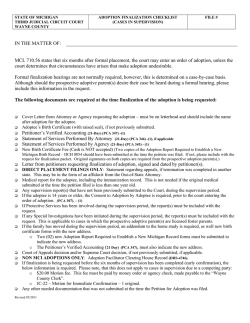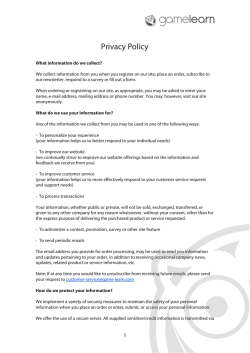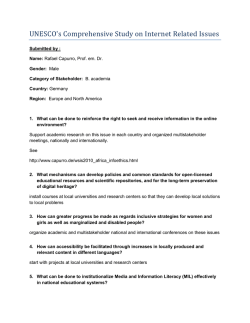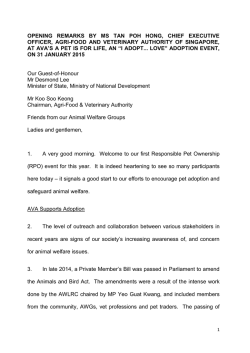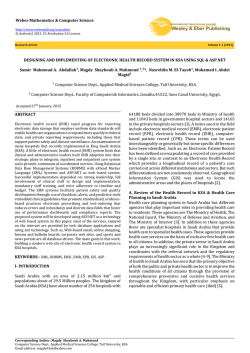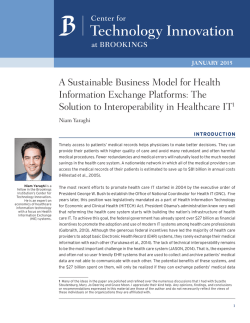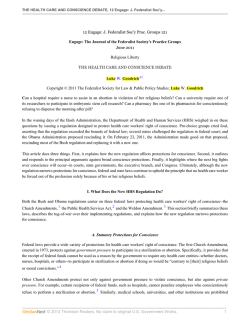
Federal Health IT Strategic Plan, 2015-2020 (PDF)
FEDERAL HEALTH IT STRATEGIC PLAN 2015 – 2020 Prepared by: The Office of the National Coordinator for Health Information Technology (ONC) Office of the Secretary, United States Department of Health and Human Services http://healthit.gov LETTER FROM THE NATIONAL COORDINATOR Over the past five years, our nation has experienced a remarkable transformation in the collection, sharing, and use of electronic health information. Updating the Federal Health IT Strategic Plan 20152020 (Plan) has given us a chance to reflect on our health IT journey. When we released the prior Plan in 2011, adoption of health IT among hospitals and health care providers was in its nascent stages, Affordable Care Act implementation was commencing, and the use of mobile health applications, especially by consumers, were far from ubiquitous. Implementation of the prior Plan created a strong foundation for achieving this Plan’s goals and objectives. Over 400,000 eligible hospitals and professionals participate in the Medicare and Medicaid Electronic Health Record (EHR) Incentive Programs. This incredible achievement was not easy. Hospitals and health care providers have invested capital, time, and hard work to digitize their patient medical records. This has created a strong demand for the seamless sharing of information across technology systems, information platforms, location, provider, or other boundaries. There is also a strong interest among providers not participating in the EHR Incentive Programs to collect, share, and use interoperable health information. With this updated Plan, the federal government signals that, while we will continue to work towards more widespread adoption of health IT, efforts will begin to include new sources of information and ways to disseminate knowledge quickly, securely, and efficiently. The first two goals of this Plan prioritize increasing the electronic collection and sharing of health information while protecting individual privacy. The final three goals focus on federal efforts to create an environment where interoperable information is used by health care providers, public health entities, researchers, and individuals to improve health, health care, and reduce costs. This Plan aims to remain flexible to our evolving definitions of health and health care. We recognize that both traditional and nontraditional sources will engender valuable health information. Expectations for our information systems and users of these systems will increase. During the information age, innovation and technological advancements have been difficult to predict. This Plan accounts for how the federal government views our nation’s current landscape and articulates our values and priorities in shaping tomorrow’s landscape. I am incredibly grateful for the participation of over thirty-five federal entities who worked in concert to develop this Plan, demonstrating the widespread interest across the government to digitize the health experience for every American. Federal authorities and investments will seek to achieve this Plan’s strategies. However, this is a shared undertaking. Efforts of state, local, and tribal governments, and private stakeholders are vital to ensure that health information is accessible when and where it is needed to improve and protect people’s health and well-being. Karen DeSalvo, MD, MPH, MSc National Coordinator for Health Information Technology Federal Health IT Strategic Plan 2|Page FEDERAL HEALTH IT VISION AND MISSION Vision Health information is accessible when and where it is needed to improve and protect people’s health and well-being Mission Improve health, health care, and reduce costs through the use of information and technology Federal Health IT Strategic Plan 3|Page INTRODUCTION Overview Improving the secure availability and use of health information allows individuals to take ownership over their health, partner with their health care providers, and improve their quality of life and health. It strengthens the delivery of health care and long-term services and supports, and allows public health agencies to detect, track, manage, and prevent disease outbreaks. Information also fuels research and innovation, spurring advancements in scientific discovery. Health information technology (health IT) allows individuals and health care entities and providers, home- and community-based supports, and public health entities to electronically collect, share, and use health information. The term “health IT” includes a wide range of products, technologies, and services, such as electronic health records (EHRs), mobile and telehealth technology, cloud-based services, medical devices, and remote monitoring devices, assistive technologies, and sensors. Federal agencies provide direct care and health insurance, protect public health, fund health and human services for certain populations, invest in infrastructure, develop and implement policies and regulations, and advance groundbreaking research. Given this range of activities, the federal government is also positioned to improve health, health care, and reduce costs through the secure use of information and technology. The Federal Health IT Strategic Plan 2015-2020 (Plan) identifies the federal government’s health IT priorities. While this Plan focuses on federal strategies, achieving the vision and goals requires collaboration from state, local, and tribal governments. Efforts by health care entities and providers, public health entities, payers, technology developers, community-based nonprofit organizations, homebased supports, and academic institutions are also essential. Background The Health Information Technology for Economic and Clinical Health (HITECH) Act, passed as part of the American Recovery and Reinvestment Act of 2009, requires the National Coordinator for Health Information Technology (National Coordinator), in consultation with other appropriate federal agencies, to update and republish the Plan. The Office of the National Coordinator for Health Information Technology (ONC) released the Federal Health IT Strategic Plan 2011-2015 when the Centers for Medicare & Medicaid Services (CMS) was launching its EHR Incentive Programs and the document was closely aligned with the HITECH Act implementation. Since 2011, the health IT ecosystem has changed. As of June 2014, 75 percent (403,000+) of the nation’s eligible professionals and 92 percent (4,500+) of eligible hospitals received incentive payments from the EHR Incentive Programs. Innovation also occurred in mobile health applications and other health technologies. HHS’ 2014 Report to Congress on Health IT Adoption and Exchange highlights federal Federal Health IT Strategic Plan 4|Page efforts across the government to advance health IT adoption and exchange. Additionally, passage of the Affordable Care Act (ACA) has also directed federal efforts toward ensuring health IT can support higher quality, more affordable care, delivered in efficient ways. Strategic Goals, Objectives, and Strategies The Federal Health IT Strategic Plan 2015-2020 describes the government’s strategies to achieve five goals: Objectives, outcomes, and strategies further define each goal. Outcomes are broken into 3-year and 6-year timeframes to achieve results. Federal departments and agencies listed under each outcome have a role in achieving that respective outcome. That role can include using their authorities and programs to advance progress towards that desired outcome, but may also include the department or agency using health IT while providing direct care or support services. Federal entities will concurrently implement the goals, objectives, and strategies across the Plan, not sequentially working to achieve each goal. For this Plan, “providers” is meant to be a broadly inclusive term for health care workers and service providers in all settings – including, for example, acute and ambulatory care, long-term services and supports, post-acute care, behavioral health, emergency medical services, home health, oral health, and end-stage renal disease dialysis facilities, pharmacies, laboratories, and public health entities. Federal Health IT Strategic Plan 5|Page Successful implementation of the Plan will also mean that health IT is culturally and linguistically sensitive, safe, accessible for everyone (including those with limited English proficiency or with disabilities), intuitive, functional, and provides a rewarding user experience. Strategic Plan Development & Update To update the federal health IT goals and objectives, ONC convened the Federal Health IT Advisory Council, an internal forum to discuss program alignments for existing and emerging health and health IT matters, to prioritize strategies and define implementation accountabilities within the Plan, and to coordinate federal health IT policy decisions. ONC drafted the Plan in consultation with over thirty-five participating agencies comprising the Federal Health IT Advisory Council. These federal partners encompass broad departmental missions with regulatory, health care provider, payer, human services, and privacy and security responsibilities. Collectively, the Council conveyed a diverse understanding of the unique needs and concerns of their stakeholders to ensure the Plan’s direction would allow for varied approaches and methods to improve individuals’ well-being and advance health IT’s capacity to achieve broad health and care goals. Representative entities comprising the Federal Health IT Advisory Council are included at the conclusion of this Plan. Through a framework established for ONC’s federal advisory groups, particularly the Health IT Policy Committee and its Strategy and Innovation Workgroup, ONC will obtain public input and request stakeholder engagement to continue development of the Plan’s content. Additionally, ONC will accept formal public comments on the Plan through February 2015. Based on this feedback, the federal government will release a final version of the updated Plan in 2015. Federal partners, in coordination with federal advisory committees, including the Health IT Policy and Standards Committees, interagency groups, and ONC, will implement the Plan and review progress for each goal, including identifying milestones, measurement and reporting tools, and risk mitigation. Each department and agency listed under an outcome will report on progress measures or milestones annually through the Federal Health IT Advisory Council. The participating agencies are committed to continually assessing and maintaining the Plan as a living document that will serve as a basis for future health IT initiatives. ONC is also developing a shared Nationwide Interoperability Roadmap to advance the use of interoperable health information. Interoperability is a crosscutting component of this Plan, and implementation of the Roadmap will be necessary to advance the Plan’s goals. Furthermore, continued outreach to stakeholders for all the federal partners involved in the Plan’s development and implementation will allow the Plan to evolve as the health IT marketplace matures, subsequently requiring new or modified approaches to policies and federal activities. This engagement will also seek to provide the public with a better understanding of the federal government’s direction to improve health care, individual and community health, and research through the collection, sharing, and use of interoperable health information. Federal Health IT Strategic Plan 6|Page FEDERAL HEALTH IT PRINCIPLES Federal agencies will collaborate with one another and with state, local, tribal, and private stakeholders to: Focus on value. Federal health IT policy will continuously target solutions that improve health and care quality, efficiency, safety, affordability, and access. Respect individual preferences. Person-centered care embraces the value of the individual inside and outside the health system, where all entities honor individuals’ privacy, needs, values, and choices regarding their information, health, and care. Build a culture of electronic health information access and use. Federal actions will help establish an environment where secure universal health information exchange and use are expected and accepted so that everyone benefits from simple, timely, equitable, efficient, and appropriate electronic access to and sharing of health information. Create an environment of continuous learning and improvement. Federal policies and actions seek to strengthen feedback loops between scientific and health care communities to translate evidence into clinical practice and other settings, and learn how to perform better. Encourage innovation and competition. The government’s policies, guidance, and programs will support continued innovation and competition in the health IT marketplace to foster highly useful health IT solutions that lead to better health and care. Be a worthy steward of the country’s money and trust. The government seeks to use its resources judiciously. This means relying to the extent possible on private markets to accomplish important societal objectives, and acting to correct market failures when necessary. It also means developing governmental policies through open and transparent processes. Federal Health IT Strategic Plan 7|Page FEDERAL HEALTH IT GOALS Share Collect Goal Goal 1: Expand Adoption of Health IT Objective • Objective A: Increase the adoption and effective use of health IT products, systems, and services • Objective B: Increase user and market confidence in the safety and safe use of health IT products, systems, and services • Objective C: Advance a national communications infrastructure that supports health, safety, and care delivery Goal 2: Advance Secure and Interoperable Health Information • Objective A: Enable individuals, providers, and public health entities to securely send, receive, find, and use electronic health information • Objective B: Identify, prioritize, and advance technical standards to support secure and interoperable health information Use • Objective C: Protect the privacy and security of health information Goal 3: Strengthen Health Care Delivery • Objective A: Improve health care quality, access, and experience through safe, timely, effective, efficient, equitable, and person-centered care • Objective B: Support the delivery of high-value health care Use Goal 4: Advance the Health and Well-Being of Individuals and Communities • Objective A: Empower individual, family, and caregiver health management and engagement Use • Objective C: Improve clinical and community services and population health Goal 5: Advance Research, Scientific Knowledge, and Innovation • Objective A: Increase access to and usability of high-quality electronic health information and services • Objective B: Protect and promote public health and healthy, resilient communities • Objective B: Accelerate the development and commercialization of innovative technologies and solutions • Objective C: Invest, disseminate, and translate research on how health IT can improve health and care delivery Federal Health IT Strategic Plan 8|Page Goal 1: Expand Adoption of Health IT The HITECH Act intended to accelerate the adoption and use of health IT. The HITECH Act authorized CMS to provide financial incentives to eligible hospitals, Critical Access Hospitals, and eligible professionals to adopt and meaningfully use certified EHR technology to improve patient care. Incentive payments dramatically accelerated broad use of EHRs by hospitals and providers. However, gaps and challenges remain for nationwide health IT use. This goal aims to expand health IT adoption and use efforts across the care continuum, emphasizing assistance for health care providers serving long-term and post-acute care, behavioral health, communitybased, and other populations ineligible to participate in the Medicare and Medicaid EHR Incentives Programs. In addition, this goal aims to expand the adoption and use of a broader set of technologies, including telehealth and mobile health. Digitizing health information collection allows for easier, appropriate sharing of that high-quality, accurate, and relevant information to connect care and empower individuals to manage their health and well-being. Federal Health IT Strategic Plan 9|Page Objective 1A: Increase the adoption and effective use of health IT products, systems, and services To realize information-fueled health and well-being, federal efforts aim to encourage broad adoption and use of health IT solutions across all provider and care settings. EHR adoption among hospitals and physicians has dramatically increased since the passage of the HITECH Act, but health IT use remains low among providers practicing in long-term services and supports, post-acute care, and behavioral health settings. It is important to capture electronic health information from all sources in order to obtain a more complete picture of overall health. The use of telehealth and mobile health technologies also remains low. Greater use of these technologies has the potential to significantly impact the quality and cost of care. Strategies 1. Encourage the use of certified health IT products through federal payment policies, contracts, and public and private programs that fund or provide health care and longterm supports and services 2. Expand the capacity of the workforce to support use of health IT 3. Establish technical guidance and standards, provide technical assistance, and identify and promote proven practices in the development, design, purchase, tailoring, and deployment of health IT 4. Encourage the adoption of telehealth and mobile technologies among providers and individuals, focusing on federal programs funding and/or providing health care, in care and payment innovation model initiatives, and those encouraging broadband adoption 5. Expand the ONC HIT Certification Program to certify products useful for providers across the care continuum Federal Health IT Strategic Plan 10 | P a g e Objective 1B: Increase user and market confidence in the safety and safe use of health IT products, systems, and services For the nation to collectively move to an electronic health environment, individuals, health care providers, and organizations need confidence that health IT solutions are secure, safe, and useful. Evidence suggests health IT improves patient safety; however, health IT products can also lead to medication errors and other adverse outcomes. Additionally, poor implementation or improper use of otherwise safe systems can also lead to adverse outcomes. Clinical and other health providers and individuals must be able to rely on health IT systems to perform safely. Individuals and providers must also have the ability to change health IT products, systems, or services without undue financial burden or the loss of valuable information. The implementation of this Plan, as well as the 2013 HHS Health IT Patient Safety Action and Surveillance Plan and the 2014 FDASIA Health IT Report, will build and maintain confidence in the safety of the health IT solutions, as well as support a competitive and innovative market. Strategies 1. Support the identification, monitoring, and reporting of complete, precise, and accurate challenges and hazards of health IT design and use 2. Integrate evidence on safe use of health IT into health IT certification 3. Encourage the application of human factors, health literacy, and user-centered design in the development and use of health IT products, systems, and services Implement a balanced, transparent, and risk-based approach to health IT oversight 4. 5. Develop, select, promote, and implement health IT standards in transparent ways that promote competition, foster innovation, and minimize barriers to market entry for developers and users 6. Promote data portability and interoperability to encourage competition, foster innovation, improve individuals’ and providers’ choices, and reduce barriers to change health IT products, systems, and services Federal Health IT Strategic Plan 11 | P a g e Objective 1C: Advance a national communications infrastructure that supports health, safety, and care delivery A strong national communications infrastructure is a prerequisite for sharing electronic health information among providers and individuals, delivering telehealth solutions, and using mobile health applications. While efforts are underway to bring broadband to all Americans, in rural areas, nearly one-fourth of the population, and in tribal areas, nearly one-third of the population lack access to broadband services. Even in areas where broadband is available, approximately 100 million Americans still do not subscribe. This inhibits the sharing of high-quality data and graphics, such as medical images, and the ability to leverage video telecommunications needed for telehealth. Expanded high-speed wireless and broadband services will support health information sharing and use, support the communication needs required for care delivery, and support the continuity of health care and public health services during public health emergencies and natural disasters. Strategies 1. Use federal authorities and investments to improve access to and choice of broadband and wireless networks 2. Encourage comparable upload and download speeds for consumers and providers in rural and other underserved communities 3. Ensure that the national health IT and telecommunications infrastructure are secure, resilient, and operational during public health emergencies and disasters Federal Health IT Strategic Plan 12 | P a g e Goal 2: Advance Secure and Interoperable Health Information The significant progress in digitizing the collection of health information has increased the demand to securely share health information electronically and use it to improve health and health care. Aligning closely with the Nationwide Interoperability Roadmap, this goal aims to stimulate secure and seamless health information sharing and use, advancing the five core building blocks for a nationwide interoperable 1 health information infrastructure: core technical and vocabulary standards and functions; certification to support the adoption and effective use of health IT products and services; privacy and security protections for health information; supportive business, clinical, cultural, and regulatory environments; and rules of engagement and governance. The ONC HIT Certification Program serves as a valuable mechanism for promoting the use of common standards for interoperability; however, significant work remains. In order to promote consistent standards implementation and reduce implementation variability, the federal government will continue to work with standards development organizations (SDOs) and industry stakeholders to assure that newer versions of standards and implementation specifications more clearly and more often describe discrete requirements. We will also identify and collaborate on the development and deployment of more modular technical standards and specifications for nationwide interoperability that can allow for more seamless transitions to new technology systems in the future. Initially, federal efforts will focus on efficiently addressing prioritized standards that enable sending, receiving, finding, and using a basic set of essential health information. Interoperable health information and health IT solutions will lead to more efficient and effective health systems, better clinical decision support, scientific advancement, and a continuously learning health system. 1 “the ability of two or more systems or components to exchange information and to use the information that has been exchanged” IEEE Standard Computer Dictionary: A Compilation of IEEE Standard Computer Glossaries (New York, NY: 1990) Federal Health IT Strategic Plan 13 | P a g e Objective 2A: Enable individuals, providers, and public health entities to securely send, receive, find, and use electronic health information Since the passage of the HITECH Act, certain types of health information exchange and use among providers have increased; however, gaps and challenges remain for widespread secure and interoperable health information across health care and long-term supports and services providers, settings of care, individuals, health IT platforms, and payers. Interoperable exchange of health information allows individuals, providers, public health departments, and payers to find, securely exchange, and use vital health information, enhancing care delivery, public health, and research, and empowering individuals to make informed choices regarding their health. Strategies 1. 2. 3. 4. 5. Establish rules of engagement and a governance mechanism related to standards, data policy, and operations, for electronic health information exchange to facilitate security and interoperability across all types of entities and networks that provide exchange services and safeguards for appropriate levels of information access Work with partners to reduce regulatory and business challenges that impact health information exchange Promote the coordination of care for individuals across the care continuum through innovative care and payment models, shared care plans, and value-based purchasing Ensure health IT products and services support the privacy, technical, and vocabulary standards necessary for capturing, finding, exchanging, and using standard health information across the health care and long-term services and supports continuum, and with individuals and public health entities Encourage electronic information sharing between public and private health providers and payers to promote care continuity Federal Health IT Strategic Plan 14 | P a g e Objective 2B: Identify, prioritize, and advance technical standards to support secure and interoperable health information Health information is only useful if the end user can access and understand the information. Standards are the medium for individuals, health IT solutions, and medical devices to find, organize, exchange, secure, and share information. They must be maintained and enhanced based on feedback from real use and to accommodate emerging requirements, including use of genomic data to achieve precision medicine. Use of common technical standards and specifications are necessary for health information to move seamlessly and securely. While not all information can be standardized, recognizing that valuable provider and patient observations and other notations may be more helpful as free text, health IT should aim to identify methods to capture and present this nonstandard information in more uniform ways. Using data elements consistently and reliably will allow for collecting information for individual health needs as well as for reuse of that information to drive decision support, quality measurement and reporting, population health management, public health, and research. Focusing on the highest priority standards can help accelerate their widespread adoption more quickly. Strategies 1. 2. 3. 4. 5. 6. Encourage consistent standards implementation, reduce implementation variability, and improve modularity in health data standards for terminology and vocabulary, coding, data content and format, transport, and security Require that certified health IT products and services have functions that facilitate users’ compliance with requirements related to privacy and security Advance technical and electronic methods to accurately identify, proof, match, and authenticate information across data sources Advance standards that support interoperability between medical devices and certified health IT products and systems, including standards for documentation of medical device use by unique device identifier and methods for adverse event reporting Advance standards for common data elements to enable capture and use for clinical decision support, clinical quality measures, and reporting Encourage the adoption and use of prioritized sets of common standards through health IT certification, federal regulations and programs, and research funding mechanisms Federal Health IT Strategic Plan 15 | P a g e Objective 2C: Protect the privacy and security of health information As more health information becomes digitized and shared, it is important that all stakeholders recognize their responsibility in protecting health information. The government will provide oversight and guidance to ensure that stakeholders adhere to laws that protect the privacy and security of health information. Aligning with the HHS’ Secretary’s Strategic Initiative highlighted in the HHS Strategic Plan 2014-2018 federal actions seek to protect patients’ health information, as it is electronically stored and shared and their privacy rights. The federal government is committed to encouraging the development and use of policy and technology to advance patients’ rights to access, amend, and make choices for the disclosure of their electronic health information. The federal government also supports the development of policy, standards, and technology to facilitate patients’ ability to control the disclosure of specific information that is considered by many to be sensitive in nature (such as information related to substance abuse treatment, reproductive health, mental health, or HIV) in an electronic environment. The privacy and security of protected health information is a top priority of the federal government, and the government will continue to pursue efforts that ensure confidence and trust for individuals and their families, caregivers, providers, and others. Strategies 1. 2. 3. 4. 5. 6. Support the development and implementation of policies, practices, and education that protect health information from breach, and address cybersecurity risks and developing technologies Continue development, administration, and enforcement of federal privacy and security regulations and standards for HIPAA-covered entities and business associates Support the development of policies, standards, technology, guidance, and solutions to facilitate individuals’ ability to manage, control, and authorize the disclosure of specific electronic health information Require and test that certified health IT products incorporate privacy and security safeguards Support, promote, and enhance the establishment of a single health and public health Information Sharing and Analysis Center (ISAC) for bi-directional information sharing about cyber threats and vulnerabilities between the private health care industry and the federal government Continue enforcement of applicable federal privacy and security requirements for entities not covered by HIPAA Federal Health IT Strategic Plan 16 | P a g e Goal 3: Strengthen Health Care Delivery The U.S. health care and long-term supports and services delivery system is often fragmented, leaving individuals and their families to seek care from multiple providers who often have little access to essential information on that person, or cutting edge therapeutic findings, and who have limited financial incentives to carefully coordinate care, including across care settings. In this environment, fee-for-service payment, which reimburses for each service provided rather than by the quality or value of care and the outcome, may not incentivize practices that emphasize quality of care. New care models based on value and quality exist, but transitioning takes time, investment, and behavioral shifts from all stakeholders. The intent of new care models is to provide the care that each individual desires as they establish and achieve their health goals. Health IT is essential for a health care system based on value and quality improvement. This goal and respective objectives aligns with multiple national strategies to improve specific components of health and health care, including quality, prevention, disparities reduction, health security, and safety. The Plan aims to remain flexible in its strategic actions and tactics to allow agencies engaged in achieving these aims to test and experiment various approaches so the public can derive the most benefit from federal policy and programs and align with state, local and private efforts. Expanded use of health IT that combines decision supports and quality measures will allow the nation to achieve continuous quality improvement and important health outcomes, including aiding in the prevention of chronic and debilitating disease, making care safer and more person-centered, and assisting communities in promoting wellness and continuity of care, particularly for their most vulnerable individuals. Federal Health IT Strategic Plan 17 | P a g e Objective 3A: Improve health care quality, access, and experience through safe, timely, effective, efficient, equitable, and person-centered care Health IT enhances health care and long-term supports and services delivery. Information exchanged and used electronically improves the ability of providers to make well-informed and coordinated care decisions quickly and safely. Implementation of the HITECH Act’s provisions has led to widespread adoption and use of health IT, developing the infrastructure necessary to accomplish a central intent of the Affordable Care Act: affordability, access, and quality. Health IT can also help equip individuals and their families with information to engage with their providers and care teams to actively participate in their own care, both by working efficiently in making informed care decisions, and in managing their health outside of the formal health care and long-term supports and services system. Expanded use of health IT will allow the nation to achieve important health outcomes, including aiding in the prevention of chronic and debilitating disease, ensuring accessible care, making care safer and more person-centered, and advancing a culture of continuous quality improvement. Strategies 1. 2. 3. 4. 5. 6. Incorporate telehealth and mobile health technologies and services within federal programs funding or providing health care and innovation model initiatives to improve access to and quality of health care services Promote the well-designed incorporation of usable electronic information, clinical quality measurement, safety and adverse event information, and clinical decision support into clinical workflow Develop and encourage the use of automated tools for testing and validating information used in capturing and reporting quality measures Develop health IT solutions that allow federal regulatory agencies to receive and evaluate pharmaceutical, biologic, and medical product risks more efficiently and promote the safe use of these products Encourage health IT use to collect and integrate person-reported outcomes, accommodations, and preferences as part of routine health care and long-term supports and services delivery Address the health literacy issues for different individual and caregiver populations so that the technology matches and improves their health management skills Federal Health IT Strategic Plan 18 | P a g e Objective 3B: Support the delivery of high-value health care Health IT will play a crucial role in supporting new care models that are person-centered and valuedriven. Seamless interoperability will facilitate better tracking of provider- and person-focused outcomes, efficient resource use and cost analyses, particularly for care provided across multiple systems and settings. Federal efforts include creation of evidence-based tools, persuasive health care provider incentives, alignment of payment reforms that reward coordinated care, and an emphasis on achieving improved health and care for all Americans. The federal government will work to help align quality and other reporting requirements, which will reduce administrative burden among all health care providers, and give them more time to focus on care and services. Interoperable health information provides a foundation to measure, report, and provide feedback on care quality for a number of purposes. For example, these efforts will help support clinicians in practice transformation efforts by making essential health information available for care decisions and patient health management. Strategies 1. 2. 3. 4. Leverage health IT to improve the accuracy and consistency of documentation and coding Use health IT to simplify participation and reporting requirements across programs for quality and claims information Improve the capacity of electronic information sources to support providers’ ability to accurately and efficiently report and receive feedback on health care quality measures for public and private programs Provide health IT implementation and usability support to health care and long-term supports and services providers to help them succeed in innovation models and use IT solutions to evaluate and manage cost, complexity, and outcomes to aid their organizational and clinical processes and practices 5. Advance multi-source data integration, innovative data use agreements, open data sources, and reliable connectivity and computational power to connect care across time, geography, and appropriate users of health information Federal Health IT Strategic Plan 19 | P a g e Objective 3C: Improve clinical and community services and population health High-quality, accurate, and relevant electronic health information improves the ability of providers to manage and advance population health. Having complete information about the person is critical to achieving population health goals. This requires health IT capable of receiving and integrating individual health information from multiple sources to enable providers to aggregate and trend information within and across groups. This allows providers to easily identify and close care gaps, recognize and analyze patterns and anomalies, and to perform localized research that can contribute to broader knowledge advancements. For example, health IT enhances routine medical care by delivering quality improvement services and prompts that are relevant to the providers’ areas of expertise and specialty, reminding providers about the timing of appropriate preventive services for their patient’s general well-being, coordinate care among providers, and begin to help connect individuals with community resources and social services to support their goals, their health and well-being, and improve their quality of life. Strategies 1. 2. 3. Promote data collection, clinical decision support, and analytic capabilities to allow for precision medicine and to identify individuals and communities that are underserved or at risk to target timely health interventions Facilitate the interoperable exchange of common data elements and quality improvement documents and tools Encourage and partner with communities to find ways for using health IT to streamline eligibility requirements and expedite enrollment processes to facilitate individuals’ access to preventive and social services 4. Encourage and partner with communities to explore ways for using health IT to facilitate coordination and implementation of complementary health strategies among clinical, behavioral, preventive services and social services 5. Encourage collaboration between public and private providers and payers to facilitate comprehensive care delivery Federal Health IT Strategic Plan 20 | P a g e Goal 4: Advance the Health and Well-Being of Individuals and Communities In many settings, an individual is often more of a recipient of health care and long-term supports and services than an active partner with their providers and care team. This dynamic limits the opportunities for individuals to manage their own health and to share in care management. Changing to a more person-centered vision is vital to improving health and health care outcomes, particularly since the individuals’ motives and actions have a great impact on their health outcomes. Individuals should be able to access wellness and health care services enabled by user-centered technology that reflects their individual needs, values, and choices, that is well-designed, and supports both self-care and meaningful interactions with their care providers. Equally important as advances in technology, settings, such as home- and community-based organizations, will redefine how we view how individuals interact with their health care. Public health entities need interoperable health information to detect, track, and manage disease outbreaks. Improved access to health information among public health entities and home- and community-based supports increases their ability to conduct and contribute to medical product safety surveillance, analyze population health trends, address local social and health determinants, protect communities during public health emergencies, and promote healthy choices for all populations and communities. This goal aims to advance exchange and use of electronic health information among individuals, homeand community-based supports, and public health entities to improve the health of individuals and communities. Federal Health IT Strategic Plan 21 | P a g e Objective 4A: Empower individual, family, and caregiver health management and engagement Changing how health and care is both discussed and provided toward a person-centered vision is vital to improve individuals’ health and quality of life. Existing and emerging technologies provide a path to make information and resources for health and health care management universal, integrated, accessible to all, and personally relevant. Empowering and supporting individuals and their families to manage their health and be a partner in their care can be a complex and time-consuming undertaking. Providers and individuals must learn new ways to communicate, collaborate, assume changing roles as part of the health team, understand new responsibilities, and learn how best to take advantage of improved health IT and care options. Health IT can help empower individuals, their families, and other caregivers to engage in shared decisionmaking with their providers on their wellness and quality of life goals, manage their health in convenient and meaningful ways, and result in better individual outcomes. Strategies 1. 2. 3. 4. Advance individuals’ ability to securely access, control, amend, and make other choices regarding the use and disclosure of their electronic individually identifiable health information and their self-generated health information in formats they can use and reuse Disseminate health IT tools and educational resources for individuals that are designed to enable them to understand their health information, costs, and care options, and to become advocates for their own health Support health IT policies that enable products that integrate self-generated health information, self-reported outcomes, and genomic information into an individual’s longitudinal care records and self-care and wellness technologies Work with partners to support providers’ and individuals’ understanding of risks and responsibilities of care options that lead to informed shared decision-making 5. Promote health IT that incorporates the provision of evidence-based health information resources, logistical support, decision aids, and risk calculators to providers Federal Health IT Strategic Plan 22 | P a g e Objective 4B: Protect and promote public health and healthy, resilient communities Interoperable health information can improve public health entities’ and community-based organizations’ ability to protect and promote healthy and resilient communities. Public health entities and human services organizations need to build the technical and administrative infrastructure to receive and make use of the increasing volume of health-related information that they receive. Health IT solutions support public health entities’ use of this information to improve and protect the health of the communities they serve. A more robust data infrastructure also promotes resource management and planning for emergency preparedness in the case of public health emergencies or medical and other disasters. Health IT can lead to faster, more efficient methods for public health departments and human services providers to protect and support community health and perform more effective needs assessments. Strategies 1. 2. 3. 4. Support the use of health IT that can help communities conduct needs assessments and protect high-risk individuals Expand the capacity for health IT and predictive analytics to assist communities in managing and preventing chronic health conditions, health care-associated infections, urgent threats, and other nationally notifiable diseases, and to promote community well-being and resilience Use health IT and integrated platforms to support resilience and mitigation of emerging hazards and public health threats Prepare public health systems and leverage health IT, communications, and integrated platforms to inform decision making to ensure continuity of appropriate care during disasters and health emergencies 5. Enhance or, if necessary, develop and maintain standards for the unique health IT needs associated with emergency care, public health emergencies, and disasters to include rapid transfers of care, unidentified individuals, and individual movement Federal Health IT Strategic Plan 23 | P a g e Goal 5: Advance Research, Scientific Knowledge, and Innovation Research drives innovation and scientific discovery. As health IT use increases among individuals, providers, and public health entities, it creates a rich source of data and exciting new opportunities to enhance clinical decision support, support quality improvement, improve post-market surveillance of the effects of biopharmacologic drugs and medical devices, enhance care transitions, and enable research on prevention, diagnosis, and treatment of disease and disability. Interoperable information collected as a byproduct of care can allow care teams to develop solutions to improve the health of the individuals receiving care and services and measure the effectiveness of their actions. This can create a continuous feedback loop that not only leads to quality improvement, but also supports more rapid translation of research findings into better care. Information from care encounters provides a partial picture of an individual’s health. Increasingly, individuals will have the ability to contribute information through mobile apps, sensors, social media, and medical devices. Care teams and researchers can leverage this information to provide person-centered care and design research studies likely to produce more useful results. Learning how to best use or develop new health IT to improve health and health care can help identify which kinds of electronic health tools and their applications are most effective in reaching personal, population, and public health needs. Electronic health data can be used to substantially improve the efficiency, effectiveness, and reach of clinical trials. Researchers can use data to identify target populations, make informed sample size estimations, recruit potential trial participants, collect more baseline data, and, within the framework of integrated health care systems or payer programs, streamline follow-up. Furthermore, conducting clinical trials within the context of existing electronic health data makes it possible to enroll a much greater proportion of potentially eligible individuals increasing the likelihood that trial results are generalizable. Federal Health IT Strategic Plan 24 | P a g e Objective 5A: Increase access to and usability of high-quality electronic health information and services While protecting privacy, security, and confidentiality, the federal government is publishing new open data sources, digitizing existing data, requiring public access to data resulting from federally-funded research, and making data easier to use via downloading, application programming interfaces, and access in the cloud. The federal government aims to encourage private-sector innovators and entrepreneurs, as well as researchers, to use government and government-funded data to create useful applications, products, services, and features that help improve health and health care. The federal efforts will also focus on accessibility, technical standards, services, policies, federal data, and governance structures that support person-centered outcomes research. This work will facilitate a learning health system that allows providers, communities, and researchers to continuously learn and advance the goal of improved health and health care. New capabilities will emerge that increasingly enhance research, allowing researchers to search data in new ways. Strategies 1. 2. 3. 4. 5. Support additional, expanded open data releases of federal and federally-funded data that relates to health, consistent with HIPAA and the Privacy Act Collaborate with private and academic research activities on strategic dataset releases, appropriate data dissemination, data discovery and location mechanisms, and education to support innovative data use Fund collaborative research data networks and infrastructure so researchers can generate and disseminate person-centered outcomes and health services research Enable and validate the electronic sharing and use of relevant EHR data in clinical trials Encourage electronic access to clinical trial data from domestic and international sources to expand person-centered outcomes 6. Promote innovation in clinical trials through strategic leveraging of health data and health IT systems in trial design and execution Federal Health IT Strategic Plan 25 | P a g e Objective 5B: Accelerate the development and commercialization of innovative technologies and solutions Open data helps create a decentralized environment for innovators across America to leverage the information to build, deploy, and scale solutions that help individuals and providers improve health and care. Beyond releasing datasets, the federal government funds innovative research for health IT products and solutions. The government also collaborates with standards-setting organizations to ensure that health IT products and solutions can use standards necessary to integrate and share person-generated health data across platforms and resources. Further, federal health systems can contribute organizational learning that leads to innovations in health IT usability and improved care delivery. Individuals should have control over the kinds of data collected about them and a full understanding of how those data may be used. The federal government plays a key role in protecting personal health information and promoting transparency in how organizations and data companies collect, use, share, and retain health information. Strategies 1. 2. 3. 4. Fund organizational learning and research, and promote innovation for new health IT products and solutions, including mobile applications, that incorporate privacy protections, wearable technologies, advances in big data, computation and analytic methods, and other scientific discoveries that use health IT securely to help resolve challenging health problems Identify methods to integrate health information securely into mobile health technologies and related social networking platforms to more effectively reach health care professionals, individuals and families while protecting the privacy of the information Develop solutions and guides for incorporating precision medicine and predictive modeling into care delivery Promote transparency in communication about what information devices are collecting and how it is being used, shared, or retained 5. Invest in methods and approaches that support distributed analytics and evidence sharing while protecting personal health information Federal Health IT Strategic Plan 26 | P a g e Objective 5C: Invest, disseminate, and translate research on how health IT can improve health and care delivery Many health IT studies focus on whether health IT improves health care and health outcomes; however, not as many studies focus on how to implement health IT solutions in ways that ensure that health IT meets its full potential. Additionally, it may take as long as one or two decades for the integration of original research results into the delivery of care and services. Thus, the translation of research findings into sustainable improvements in care provision and health outcomes remains a substantial obstacle to improving the quality of health care. Health IT can serve as a vehicle for incorporating timely, personally-relevant, evidence-based practices into care. Federal science and research play an important role in advancing evidence on how health IT can improve health outcomes, reduce health disparities, and improve care delivery, as well as how to make these systems easier and safer for people of all abilities to use. Health IT solutions can help rapidly integrate the latest evidence into care practices, leading to a more effective care delivery system. Strategies 1. 2. 3. 4. Collect, analyze, and interpret data to assess the impact of health IT use and valuebased purchasing incentives on improving health outcomes Collect, analyze, and interpret data to assess the impact of health IT use to reduce disparities in the quality, accessibility, and safety of health care and long-term supports and services Fund health services research to identify the most effective ways health IT can support organization, management, and delivery of health care and long-term supports and services Fund research to provide evidence and proven practices on use of health IT to improve the quality, safety, and value of care in care settings, among populations, and among human services organizations 5. Promote rapid translation of evidence from health services research and organizational learning into health IT products and practice transformation efforts Federal Health IT Strategic Plan 27 | P a g e Participating Federal Departments and Agencies Administration for Children & Families (ACF) HHS Assistant Secretary for Planning and Evaluation (ASPE) Administration for Community Living (ACL) HHS Assistant Secretary for Preparedness and Response (ASPR) Agency for Healthcare Research and Quality (AHRQ) Centers for Disease Control and Prevention (CDC) HHS Office of the National Coordinator for Health Information Technology (ONC) HHS Office for Civil Rights (OCR) Centers for Medicare & Medicaid Services (CMS) HHS Office of the Chief Information Officer (OCIO) Department of Agriculture (USDA) Department of Defense (DOD) HHS Office of the Chief Technology Officer (CTO) Department of Education (DOE) Department of Justice (DOJ) and Bureau of Prisons (BOP) HHS Office of the General Counsel (OGC) HHS Office of Minority Health (OMH) Department of Labor (DOL) HHS Office of the Secretary (OS) Department of Veterans Affairs (VA) Indian Health Service (IHS) Federal Communications Commission (FCC) National Aeronautics and Space Administration (NASA) Federal Health Architecture (FHA) National Institutes of Health (NIH) Federal Trade Commission (FTC) Food and Drug Administration (FDA) National Institute of Standards and Technology (NIST) Health Resources and Services Administration (HRSA) National Science Foundation (NSF) HHS Assistant Secretary for Financial Resources (ASFR) Networking and Information Technology Research and Development (NITRD) HHS Assistant Secretary for Health (OASH) Office of Personnel Management (OPM) HHS Assistant Secretary for Legislation (ASL) Social Security Administration (SSA) Substance Abuse and Mental Health Services Administration (SAMHSA) Federal Health IT Strategic Plan 28 | P a g e
© Copyright 2025
